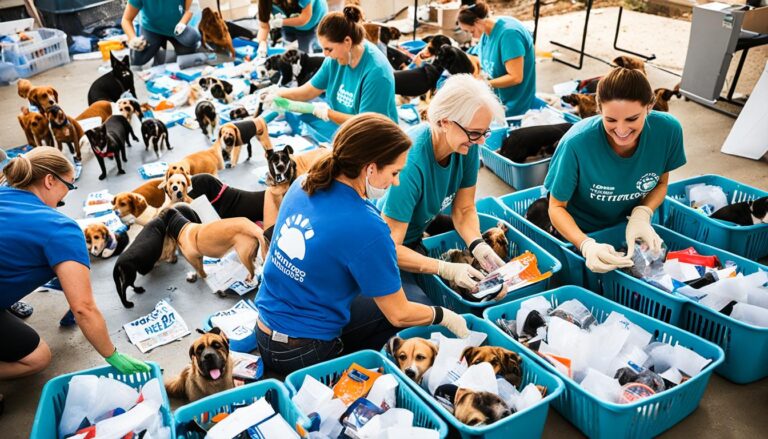how dog shelters operate
Ever wondered what happens at dog shelters? These places are key to animal welfare. They work hard but are often unknown to us. Let’s look into how they work and the love they put into it.
Dog shelters take in thousands of animals every year1. They give them food, water, and a safe place to stay1. Every year, 8 to 10 million dogs and cats end up in shelters in the U.S2..
Shelters are all about helping animals. Staff work hard all year to care for many animals3. They give shots, treat for bugs, and make sure they’re clean13. They also help pets behave better and find the right homes.
Adopting pets is a big part of what shelters do. After a while, pets can go to new homes1. Shelters also help find pets their owners and work with other groups to help more animals1. This helps with the big problem of too many pets2.
Key Takeaways
- Dog shelters take in thousands of animals every year
- They give food, shelter, and medical care
- Staff work hard all year, starting early
- Adopting pets and finding lost ones are main goals
- They face challenges like too many pets and not enough resources
- Working with other groups helps shelters do more
Understanding the Different Types of Dog Shelters
Dog shelters are key in helping animals in the United States. They come in many types, each with its own way of working and rules. In the US, around 5,000 animal shelters run by themselves help homeless pets4.
Municipal vs. Private Shelters
Municipal shelters are run by the government and get money from local taxes. Private shelters get most of their money from donations and are run by nonprofits. They work hard to pay for things like food, training for staff, and programs for the animals5.
Open Admission vs. Limited Admission Shelters
Open admission shelters take in all animals, no matter their health or behavior. Limited admission shelters might not take in as many animals because they don’t have enough resources. This affects how they use their resources and care for the animals.

No-Kill Shelters and Their Policies
No-kill shelters try to save at least 90% of the animals they take in. In Germany, all animal shelters are no-kill thanks to a special law4. These shelters work on making animals healthy and finding them new homes.
| Shelter Type | Admission Policy | Funding Source |
|---|---|---|
| Municipal | Often Open Admission | Government Funds |
| Private | Can be Limited or Open | Donations, Grants |
| No-Kill | Often Limited Admission | Mixed Sources |
Knowing about these shelters helps us see how complex animal welfare is. Every year, 8-12 million pets end up in shelters in the US. This shows we need different kinds of shelters and strong support from the community6.
The Daily Operations of Dog Shelters
Dog shelters are always busy. Staff and volunteers work hard to keep the animals happy and healthy. They start the day by feeding, giving fresh water, and cleaning the kennels. Many shelters can’t do this without help from volunteers7.
Every day, animal welfare is the main focus. When pets come in, they get shots, deworming, heartworm tests, and microchips8. Cats get shots for feline diseases, and dogs get shots for parvo, bordetella, and distemper9.
Staff watch how well the animals adjust to life in the shelter. They get ready for adoption by learning about each animal’s personality and behavior. This helps find the best home for them7. Some shelters use special tests or programs to match dogs with the right homes9.
Shelters also help the community by offering low-cost spay/neuter services and rabies clinics. These programs help control pet numbers and encourage responsible pet care.
| Daily Task | Frequency | Performed By |
|---|---|---|
| Feeding | 2-3 times daily | Staff & Volunteers |
| Kennel Cleaning | Daily | Staff & Volunteers |
| Health Checks | Daily | Veterinary Staff |
| Dog Walking | 2-3 times daily | Volunteers |
| Socialization | Throughout the day | Staff & Volunteers |
The work is hard and can be sad, especially when it’s busy. But, those who work in shelters say they need to love their job and be strong7. Their main goal is to care for the animals and find them happy homes.
How Dog Shelters Operate: Intake and Assessment Procedures
Dog shelters are key in animal welfare. We’ll look at how they take in and check dogs.
Stray Animal Intake Process
Shelters take in stray dogs found on the streets. They give each dog a special code for tracking10. This keeps records right and makes sure dogs get the right care.
Owner Surrender Protocols
Shelters have rules for when owners give up their pets. They ask for info on the pet’s past, behavior, and health. This helps decide the best care for the dog.

Initial Health and Behavior Evaluations
Right after coming in, dogs get checked for health and behavior. Shelters do this in the first day11. This fast action spots health and behavior problems early.
Tests like Sue Sternberg’s Assess-a-Pet or Emily Weiss’ SAFER test are used12. These tests show how a dog acts and if it’s good for adoption. Stress can change how a dog acts in a shelter, which might change test results12.
| Intake Step | Purpose | Timeframe |
|---|---|---|
| Identification | Assign unique code | Immediate |
| Health Check | Assess physical condition | Within 24 hours |
| Behavior Evaluation | Assess temperament | 1-3 days |
Shelters use handbooks to make behavioral tests better. Training staff in dog language and keeping tests calm helps too121011.
Medical Care and Behavioral Rehabilitation in Shelters
Dog shelters focus on animal welfare by giving medical care and rehab for behavior. Vets check animals, give emergency care, and plan ongoing care. This makes sure every dog stays healthy while in the shelter.
The ASPCA’s Behavioral Rehabilitation Center (BRC) in Weaverville, North Carolina, shows their commitment to animals. It can hold up to 65 dogs, offering special care for those with trauma or behavior issues1314. With over 30 staff, including vets, researchers, and trainers, the BRC has greatly helped dogs14.
At the BRC, dogs get a lot of help, usually for 16 weeks13. This hard work has made the center very successful, with 87% of dogs getting better14. Since starting in 2013, over 500 dogs have left the program ready for adoption14.
Shelter medicine is now key in animal care. Maddie’s Fund has given almost $25 million since 1999 to train vets in shelter medicine15. This has made shelter medicine a big part of vet training, second only to general practice15.
| Aspect | Data |
|---|---|
| BRC Capacity | 65 dogs |
| Average Rehabilitation Time | 16 weeks |
| BRC Success Rate | 87% |
| BRC Graduates Since 2013 | Over 500 dogs |
| Maddie’s Fund Investment | Nearly $25 million |
The no-kill movement has made medical and behavioral rehab in shelters more important. Shelters now keep animals longer and treat sick or hurt pets. This shows how vital shelter vets are for animal welfare15.
Adoption Processes and Shelter Partnerships
The pet adoption process is key to how dog shelters work. At Animal Humane Society, it takes up to two hours to adopt a pet16. This careful process helps pets and owners bond well and lowers the chance of pets coming back.
Adoption Screening and Matching
Shelters use careful screening to find the right homes for pets. Some places offer a 24-hour hold for a small fee16. This thoughtful process helps pets find new homes, with about 3.2 million shelter animals adopted each year in the U.S17..
Collaboration with Rescue Organizations
Working together with other groups is key to helping animals. These partnerships help place animals, support pets and families, and share good ideas18. They lead to new solutions like pet transport programs, saving many animals’ lives.
Foster Care Programs
Foster care is a big part of helping dogs. It gives them a temporary home and special care. The Virginia-Maryland College of Veterinary Medicine’s program is a great example, taking in about 30 dogs each fall for students to help and adopt17.
| Adoption Process Step | Description | Duration/Frequency |
|---|---|---|
| Initial Screening | Application review and interview | 30-60 minutes |
| Pet Meet-and-Greet | Interaction with potential adoptee | 15-30 minutes |
| Adoption Counseling | Discussion of pet care and responsibilities | 30-45 minutes |
| Paperwork Completion | Finalization of adoption documents | 15-30 minutes |
| Post-Adoption Support | Follow-up calls and resources | Ongoing |
Shelters work hard to find homes for the 6.5 million animals that enter shelters each year17. Their efforts help animals and make many families happy across the country.
Funding and Resource Management for Dog Shelters
Dog shelters have big challenges with funding and taking care of animals. Starting a rescue group can cost between $5,000 to $10,000. This money goes for food, toys, and vet care19. Shelters make money from adoption fees, donations, events, and partnerships with businesses19.
It’s important for shelters to manage their money well. They use creative ways to raise money, like dog walks and grants from groups like the American Humane Society20. Some shelters sell pet supplies to make more money. The Puppy-Friendly Pet Stores program helps pets find homes through local adoptions21.
Marketing and branding help shelters get more donors, volunteers, and adopters19. Shelters now use terms like “shelters” instead of “pounds” to look better to the public20. The Shelter Mentorship program gives grants of $10,000 to $25,000 for six months21. By controlling how many animals they take in and adopt out, shelters can take good care of animals and save money.
FAQ
What are the different types of dog shelters?
What are the daily operations involved in running a dog shelter?
How do shelters handle stray and owner-surrendered animals?
What kind of medical care and behavioral rehabilitation do shelters provide?
How do shelters facilitate pet adoptions?
How are dog shelters funded and resources managed?
Source Links
- https://www.sanjoseca.gov/your-government/departments-offices/animal-care-services/about-us – About Us | City of San José
- https://www.petplace.com/article/general/pet-health/what-do-animal-shelters-do – Animal Shelters: Where to Find Your Next Pet | PetPlace.com
- https://www.foundanimals.org/day-life-animal-shelter/ – A Day in the Life at an Animal Shelter
- https://en.wikipedia.org/wiki/Animal_shelter – Animal shelter
- https://www.humanesociety.org/resources/ten-ways-help-your-local-shelter-or-rescue – How to help animals in shelters and rescues
- https://www.petfinder.com/adopt-or-get-involved/animal-shelters-rescues/starting/facts-about-animal-sheltering/ – Facts About Animal Sheltering | Petfinder
- https://www.letlovelive.org/news/a-day-in-the-life-of-a-shelter-animal-caretaker/ – A Day in the Life of a Shelter Animal Caretaker – SPCA Albrecht
- https://wagwalking.com/daily/a-day-in-the-life-of-an-animal-shelter-volunteer – A Day in the Life of an Animal Shelter Volunteer
- https://bestfriends.org/pet-care-resources/animal-shelters-and-rescues-partner-save-pets – Animal Shelters and Rescues Partner to Save Pets
- https://www.aspca.org/investigations-rescue/rescue-work-and-field-deployments/behind-scenes-animal-rescue – Behind the Scenes of an Animal Rescue
- https://opensanctuary.org/intake/ – How To Conduct An Intake Evaluation At Your Animal Sanctuary – The Open Sanctuary Project
- https://www.maddiesfund.org/behavioral-assessment-in-animal-shelters.htm – Behavioral Assessment in Animal Shelters
- https://www.aspca.org/animal-care-recovery/aspca-behavioral-rehabilitation-center – Behavioral Rehabilitation Center
- https://www.npr.org/2020/12/24/933435001/one-of-a-kind-shelter-helps-traumatized-dogs-learn-to-trust-humans-again – 1 Of A Kind Shelter Helps Traumatized Dogs Learn To Trust Humans Again
- https://www.maddiesfund.org/what-is-the-role-of-a-veterinarian-in-animal-shelters.htm – What is the Role of a Veterinarian in Animal Shelters?
- https://www.animalhumanesociety.org/resource/how-adoption-works – How adoption works
- https://vetmed.vt.edu/news/2023/adopting-from-animal-shelters.html – Giving a Second Chance: The Importance of Adopting from an Animal Shelter
- https://www.humanesociety.org/resources/shelter-and-rescue-partners – Shelter and Rescue Partners
- https://humanepro.org/page/rescue-group-best-practices-funding-your-organization – Rescue Group Best Practices: funding your organization
- https://rucore.libraries.rutgers.edu/rutgers-lib/38418/PDF/1/play/ – PDF
- https://www.humanesociety.org/resources/how-humane-society-united-states-helps-local-pet-shelters-and-rescue-groups – How the Humane Society of the United States helps local pet shelters and rescue groups







